
Hiking Around Las Vegas, Red Rock Canyon National Conservation Area

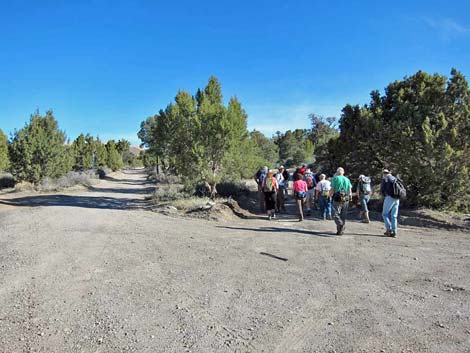 Hikers departing trailhead (view N) |
Overview This fairly strenuous, 5.2-mile (about 1,100 feet of "net" elevation gain) round-trip hike is located on the west side of the Red Rock Canyon escarpment. The access is from Highway 160 near the town of Mountain Springs. The hike starts near the edge of the Rainbow Mountain Wilderness Area and heads east to the crest of the Spring Mountains Range, entirely within the Pinyon-Juniper Woodland zone. Following the limestone crest north to a highpoint, the route turns east and descends to the sandstone escarpment. After bit of easy 3rd-class scrambling on slickrock sandstone, the route climbs past ponderosa pines to the summit. Views from the summit include the La Madre Range to the north, Las Vegas and every mountain range to the east, to Mt. Potosi in the south. Back along the route, there are also great views of Telescope Peak, Mt. Charleston, and other mountain ranges off to the west. Link to map or elevation profile. |
 Steep road runs up to telecom tower (view NE) |
Watch Out Other than the standard warnings about hiking in the desert, ...this hike is fairly safe, but there is a bit of easy 3rd-class scrambling on slickrock sandstone and falling hazards out on the end of the sandstone (i.e., at the top of the escarpment). While hiking, please respect the land and the other people out there, and try to Leave No Trace of your passage. Also, this hike is in a remote area, so be sure to bring the 10 Essentials. This route is in designated Wilderness, so please pay particular attention to respecting the land. |
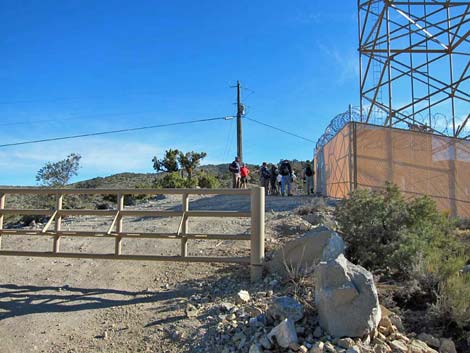 Hikers at telecom tower (view NE) |
Getting to the Trailhead This hike is located in Red Rock Canyon NCA, but over on the west side of the sandstone escarpment. From the Red Rock Visitor Center area, drive west then south on West Charleston Blvd (Hwy 159) past Blue Diamond Town to Highway 160. Turn right onto Highway 160 and drive west 9.5 miles to the Mountain Springs Trailhead, which is just before the town of Mountain Springs. |
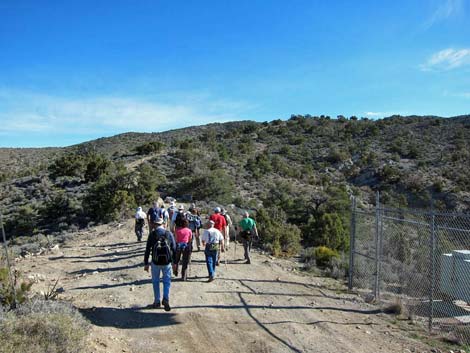 Hikers departing the telecom tower area (view NE) |
The Hike From the trailhead (Table 1, Waypoint 01), the route runs north following the right of two parallel dirt roads. The dirt road climbs steeply towards a communications tower in the distance, passing one road intersection (Wpt. 02; stay straight) along the way. Just before the communications facility, a gate blocks the road, so technically hikers could drive to this point and park on the side of the road. From the communications facility (Wpt. 03), the route follows the dirt road eastward along the ridgeline. Just past the facility, the route enters the Rainbow Mountain Wilderness Area, and people have worked to convert the old road to a trail. |
 Rehabilitated road-trail (view NE) |
Vegetation on the west side of the mountains is a fairly dense forest of singleleaf pinyon pine and Utah juniper with a variety of shrub species including blackbrush, banana yucca, mormon tea, sagebrush, turpentinebroom, narrowleaf goldenbush, silver cholla, and Utah agave. The old road, and eventually an obvious use-trail, leads up and east towards the crest of the Spring Mountain Range (Wpt. 04). The use-trail reaches the crest at a flat spot on the ridge. From this point, and for the first time during the hike, the view to the east includes the goal: Windy Peak. Note that when hiking back down from the peak, this flat spot on the ridge is not obvious, so take a good look at the area and notice the cairn before that makes the turn down the west side of the ridge. |
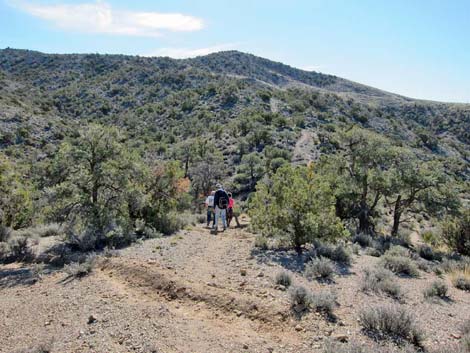 Old road on ridge leading towards the crest (view E) |
Turning north and continuing along the ridgeline, which is the crest of the Spring Mountains, the route climbs towards a highpoint. Before getting there, however, many cairns announce trail junctions (Wpt. 05 and Wpt. 06) to the left. At the first, the Windy Peak route continues straight up the hillside, and at the second, the Windy Peak route bends to the right to climb nearly due east. The trails turning left eventually converge and run north to Mountain Spring Peak and points beyond. From the second trail junction (Wpt. 06), the Windy Peak route runs across south-facing sideslopes below highest point on the ridge, gaining the highpoint of the route (Wpt. 07) just south of the peaklet. |
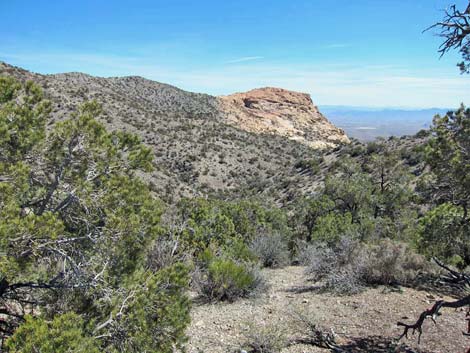 Windy Peak comes into view (view E from crest) |
From this highpoint (Wpt. 07), the route follows use-trails, faint in places, southeast as it descends along Windy Peak Ridge. The use-trail runs out to the edge of the gray limestone and continues onto yellowish sandstone. The point of contact between the two types of rock marks the world famous Keystone Thrust Fault. Geologists come from all over the world to see this classic thrust fault, so enjoy the moment hiking across it (but don't delay too long lest it thrusts again). Vegetation on the east side of the mountains is a sparse forest of singleleaf pinyon pine and Utah juniper with few shrub species including blackbrush, banana yucca, and mormon tea. This east side of the mountain must get less rain that the west side. |
 Continuing along ridgeline (view NE) |
On the sandstone, the use-trail drops into a notch on the ridge, then climbs steeply onto the sandstone ridge. Several possibilities present, but a shallow crack seems to be the easiest (3rd-class) way to climb this steepest part of the route. The route continues across slickrock sandstone, winding among boulders and ponderosa pine, as it stays on the east side of the ridgeline. There are plenty of cairns, but none are needed because it is just a matter of winding towards the summit. At the top of the mountain, the true summit is a sloping slab of red sandstone marked with a cairn. Unfortunately, the true summit isn't the best place to lie around and contemplate the mysteries of the universe, so people congregate on a sub-summit about 100 ft southeast of the true summit. The summit register, safeguarded in an old ammo can, is located on the sub-summit, but apparently it migrates from the true summit to the false summit from time to time. |
 Routes diverge (view NE) |
On the top of the sandstone, vegetation includes a few ponderosa pines, a species usually found higher in the mountains. There must be enough water down in the rocks for these trees to survive. There are also singleleaf pinyon pine and Utah juniper on the summit, plus scrub live oak, manzanita, and skunk bush; these too usually are associated with wetter areas. Rare in the Red Rocks area, there are at least two pancake pricklypear in the summit area, plus grizzlybear pricklypear, and Heermann's buckwheat, blackbrush, and lots of colorful lichens. When ready to depart, follow your footprints back to the trailhead. |
 Descending summit ridge (view E) |
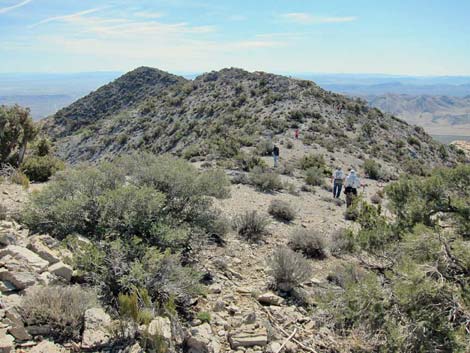 Descending summit ridge (view E) |
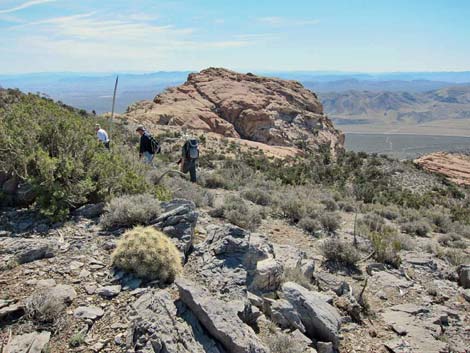 Hiking out the limestone ridge (view SE) |
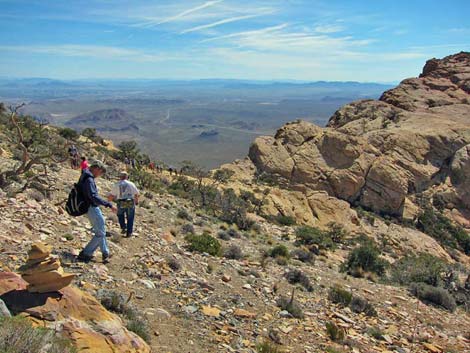 Hiking out the sandstone ridge (view S) |
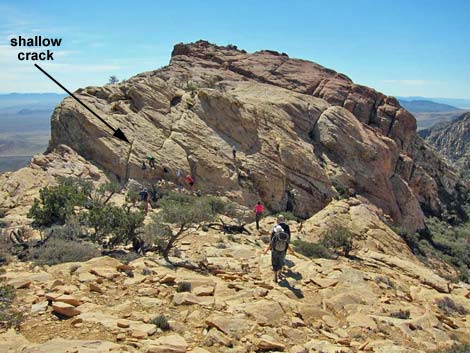 Approaching sandstone saddle (view SE) |
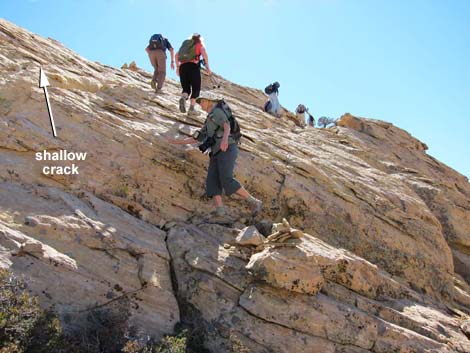 Scrambling onto the sandstone (Wpt 08; view SE) |
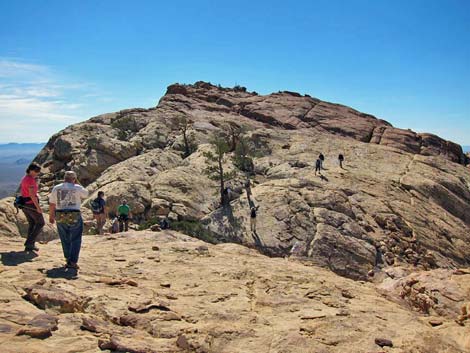 Slickrock along summit ridge (view SE) |
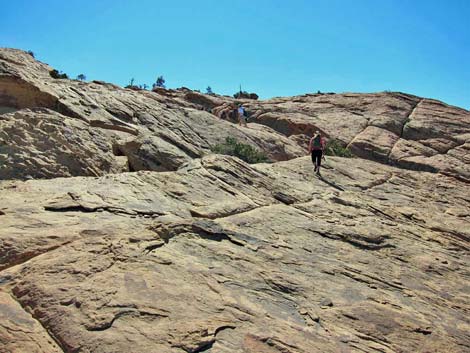 Slickrock along summit ridge (view SE) |
 Sloping summit slab (red sandstone) isn't the best place to relax, but it has a great view of Black Velvet Peak (view N). |
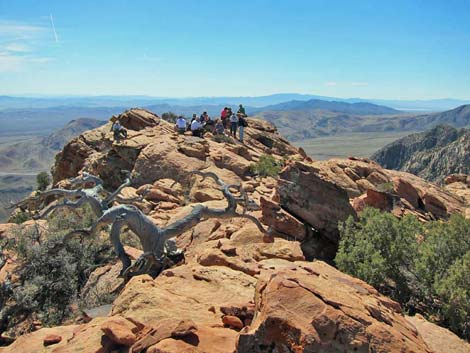 As seen from the true summit, the false summit offers plenty of room to spread out, nap, eat lunch, and enjoy the view. |
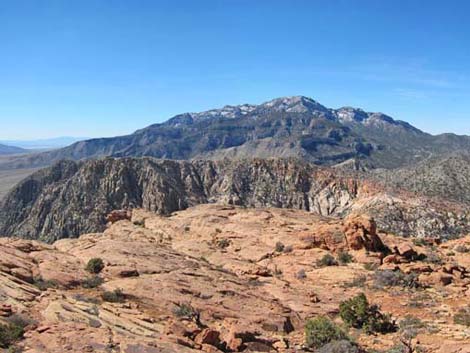 Hollow Rock Peak (ridge) and Mt. Potosi (view S) |
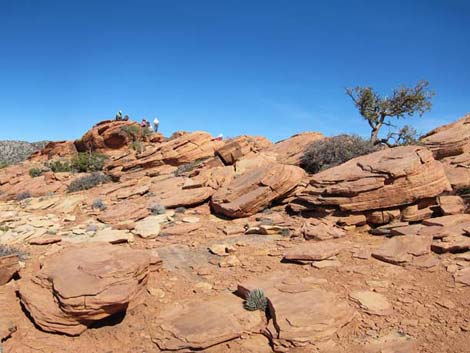 False summit (view N) |
 Cottonwood Valley and Las Vegas (view E) |
 False summit and Keystone Thrust |
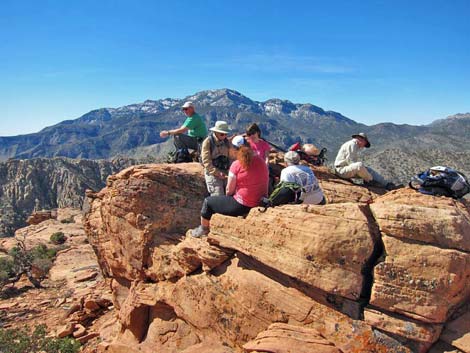 Hikers relaxing (view S towards Mt. Potosi) |
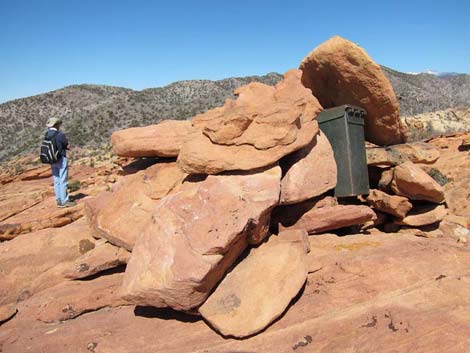 Summit register can (view N) |
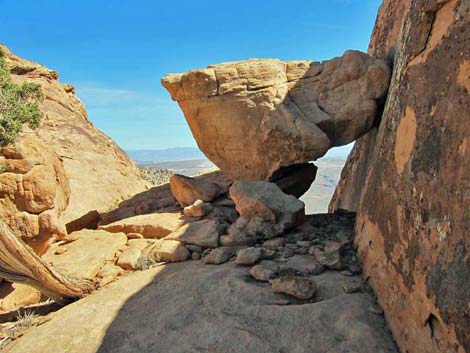 Natural "rock art" on the sandstone ridgeline (view NE) |
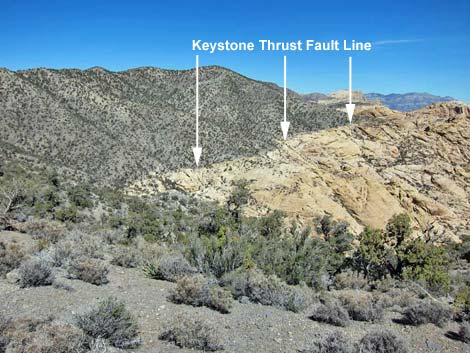 Great view of the Keystone Thrust Fault Line (view N) |
Table 1. Hiking Coordinates and Distances based on GPS Data (NAD27; UTM Zone 11S). Download Hiking GPS Waypoints (*.gpx) file.
| Wpt. | Location | Easting | Northing | Elevation (ft) | Point-to-Point Distance (mi) | Cumulative Distance (mi) | Verified |
|---|---|---|---|---|---|---|---|
| 01 | Trailhead | 635267 | 3986363 | 5,470 | 0.00 | 0.00 | GPS |
| 02 | Fork in Road | 635394 | 3986528 | 5,524 | 0.19 | 0.19 | GPS |
| 03 | Communication Tower | 635563 | 3986773 | 5,652 | 0.20 | 0.39 | GPS |
| 04 | Crest of the Range | 636370 | 3986956 | 6,012 | 0.68 | 1.07 | GPS |
| 05 | Trail Junction | 636623 | 3987573 | 6,246 | 0.46 | 1.53 | GPS |
| 06 | Trail Junction | 636648 | 3987586 | 6,336 | 0.02 | 1.55 | GPS |
| 07 | High Point | 636757 | 3987561 | 6,378 | 0.08 | 1.63 | GPS |
| 08 | Saddle before Sandstone | 637677 | 3987417 | 6,085 | 0.66 | 2.29 | GPS |
| 09 | Sub-summit | 637935 | 3987199 | 6,234 | 0.28 | 2.57 | GPS |
| 10 | Summit | 637917 | 3987224 | 6,238 | 0.02 | 2.59 | GPS |
Happy Hiking! All distances, elevations, and other facts are approximate.
![]() ; Last updated 240330
; Last updated 240330
| Hiking Around Red Rocks | Hiking Around Las Vegas | Glossary | Copyright, Conditions, Disclaimer | Home |